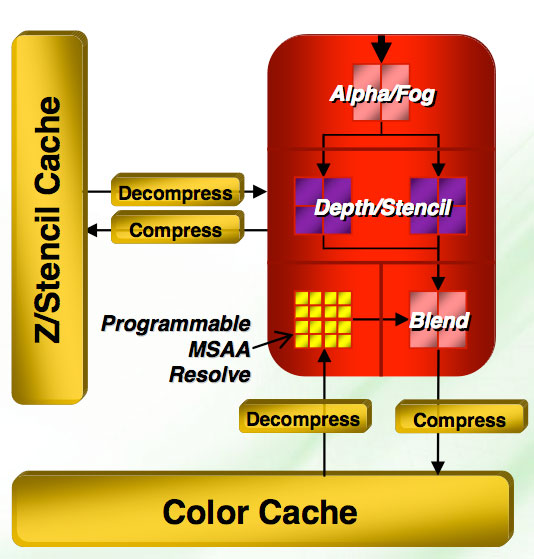ATI Radeon HD 2900 XT: Calling a Spade a Spade
by Derek Wilson on May 14, 2007 12:04 PM EST- Posted in
- GPUs
Beyond the Shader: Coloring Pixels
We can't ignore the last few steps in the rendering pipeline, as AMD has also updated their render back ends (analogous to NVIDIA's ROPs) which are responsible for determining the visibility of each fragment and the final color of each pixel on the screen. Beyond this, the render back ends handle compression and decompression, render to texture functionality, MRTs, framebuffer formats, and usually AA.
Once again, one of the important things to note is that R600 only has four render back ends. This means we will only see 16 pixels complete per clock at maximum, just like the R580. However, AMD has included double the Z/stencil hardware so that we can get up to 32 total Z/stencil ops out of the render back ends to improve stencil shadow operations among other things. Pure fill rate hasn't really mattered in a while, while Z/stencil capability remains important. But will only four render back ends be enough?

Efficiency has been improved on the render back ends, but with the potential of completing 64 threads per clock from the shader hardware, they will need to really work to keep up. R600 has the ability to display floating point formats from 11:11:10 up to 128-bit fp. DX10 requires eight MRTs now, and we've got them. We also get more efficient render to texture features which should help enable more complex effects to process faster.
Z/Stencil Hardware
As far as Z/stencil hardware is concerned, compression has gotten a boost up to 16:1 rather than 8:1 on the X1k series. Depth tests can be limited to a specific range programmatically which can speed up stencil shadows. Our Z-buffer is now 32-bit floating point rather than 24-bit. Hierarchical Z has been enhanced to handle some situations where it was unable to assist in rendering, and AMD has added a hierarchical stencil buffer as well.
AMD is introducing something called Re-Z which is designed to also help with the problem Early-Z has in not being able to handle shaders that update Z data. R600 is able to check Z values before a shader runs as well as after the Z value has been changed in the shader. This allows AMD to throw out pixels that are updated to be out of view without sending them to the render back ends for evaluation.
If we compare this setup with G80, we're not as worried as we are about texture capability. G80 can complete 24 pixels per clock (4 pixels per ROP with six ROPs). Like R600, G80 is capable of 2x Z-only performance with 48 Z/stencil operations per clock with AA enabled. When AA is disabled, the hardware is capable of 192 Z-only samples per clock. The ratio of running threads to ROPs is actually worse on G80 than on R600. At the same time, G80 does offer a higher overall fill rate based on potential pixels per clock and clock speed.










86 Comments
View All Comments
imaheadcase - Tuesday, May 15, 2007 - link
Says who? Most people I know don't care to turn on AA since they visually can't see a difference. Only people who are picky about everything they see do normally, the majority of people don't notice "jaggies" since the brain fixes it for you when you play.
Roy2001 - Tuesday, May 15, 2007 - link
Says who? Most people I know don't care to turn on AA since they visually can't see a difference.------------------------------------------
Wow, I never turn it of once I am used to have AA. I cannot play games anymore without AA.
Amuro - Tuesday, May 15, 2007 - link
Says who? No one spent $400 on a video card would turn off AA.
SiliconDoc - Wednesday, July 8, 2009 - link
Boy we'd sure love to hear those red fans claiming they turn off AA nowadays and it doesn't matter.LOL
It's just amazing how thick it gets.
imaheadcase - Tuesday, May 15, 2007 - link
Sure they do, because its a small "tweak" with a performance hit. I say who spends $400 on a video card to remove "jaggies" when they are not noticeable in the first place to most people. Same reason most people don't go for SLI or Crossfire, because it really in the end offers nothing substantial for most people who play games.
Some might like it, but they would not miss it if they stopped using it for some time. Its not like its make or break feature of a video card.
motiv8 - Tuesday, May 15, 2007 - link
Depends on the game or player tbh.I play within ladders without AA turned on, but for games like oblivion I would use AA. Depends on your needs at the time.